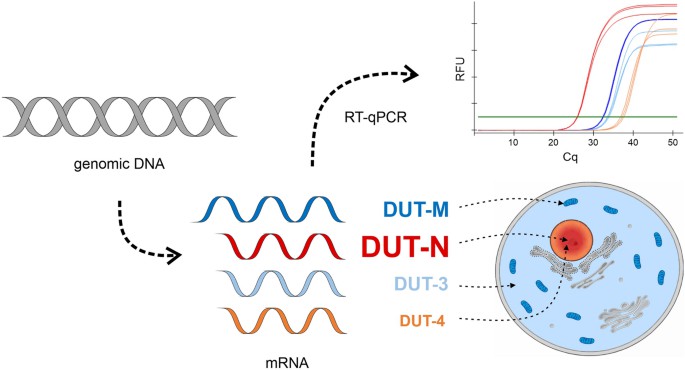What is DUT Protein
The Deoxyuridine Triphosphatase (DUT) protein, an enzyme encoded by the DUT gene in humans, has intrigued scientists for decades since its discovery. This protein's functionalities, related diseases, and burgeoning role in biomedicine have begun to shed light on its incredible potential and latitude of influence.
The DUT protein's history starts about four decades ago. It came into significant consideration in the late 1980s when scientists discovered the human DUT gene, located on the 15th chromosome at 15q21.1 in the genome. The nonlinear and complex structure of the DUT protein is encoded by this gene. Though it's a relatively small protein, containing only 164 amino acids, its job is crucial in maintaining cells' genomic integrity.
Structurally, the DUT protein is a homotrimer. Each monomer consists of four β-sheets and three α-helices. The three monomer molecules align to form a perfect catalytic centre, essential for its function. This feature means the structure is stable, and even minimal changes could yield significantly different outcomes.

Fig1. DUT isforms (Rácz, G. A. et al. 2023)
Function of DUT protein
The primary function of the DUT protein lies in the metabolism of nucleotides within cells. More specifically, it operates within the pathway of pyrimidine metabolism, where it hydrolyzes dUTP to the monophosphate form, dUMP, and PPi. This metabolic action prevents uracil residues from incorporating into DNA, thus safeguarding the genetic integrity of cells. Given the importance of DNA for cellular activity, it is paramount to shield it from mutations and harm, hence the crucial role played by the DUT protein.
DUT protein related signal pathway
The DUT protein is integral in the signal pathway management of cells. It regulates signal pathways by acting as a negative regulator of base excision repair of DNA. This pathway is paramount in detecting and rectifying damaged DNA in a cell. This protein's action is essential in mitigating uncontrolled cell division and mutations, which are major contributing factors to the development of cancers.
DUT protein related diseases
Furthermore, research has revealed an association between DUT protein and several diseases. Variations and anomalies in the DUT protein are suspected to contribute to Microcephaly, a condition causing a small head size and brain abnormalities. Additionally, overexpression of the DUT protein has been found in clear cell renal carcinoma, bile duct cancer, and glioma, implicating it in the perpetuation of these diseases.
The role of the DUT protein extends to its capacity as an inhibitor in HIV replication. It counteracts the viral URD pathway by converting dUTP to dUMP hence, thwarting the HIV replication process. Consequently, it might be used in the development of new anti-HIV drugs.
Considering these potential pathogenic links, the DUT protein and its pathways have increasingly become a focal point for further research in disease detection and therapeutics. Developments in genetics and molecular biology have opened up opportunities to leverage this understanding of DUT protein in diagnosing and treating related conditions.
DUT protein's applications in biomedical
In the biomedical industry, the DUT protein has shown substantial potential as a target in treating clear cell renal cell carcinoma, one of the most common forms of kidney cancer. This concept is still in the experimental stages but has shown promising responses. Additionally, the study of DUT protein is propelling advances in gene therapy for diseases caused by mutations or irregularities in the DUT gene.
To conclude, the importance of the DUT protein extends beyond its role in nucleotide metabolism. With advancing research and understanding in this area, biomedical scientists envisage a future where the complexities and capabilities of the DUT protein are harnessed for discerning disease pathways, developing innovative therapeutics, and building a healthier world. The DUT protein stands as a testament to the extensive potential in the field of molecular biology and biomedical innovation. However, much more is still to be discovered about the mysteries held within this tiny but influential protein.
Our Featured Products
| Cat.No. | Product Name | Species | Source (Host) | Tag |
|---|---|---|---|---|
| dUTPase-88 | Active Recombinant Thermostable dUTPase | Human | E.coli | N/A |
| DUT-77H | Recombinant Human DUT protein, His-tagged | Human | E.coli | His |
| DUT-12221H | Recombinant Human DUT, GST-tagged | Human | E.coli | GST |
| DUT-4123HF | Recombinant Full Length Human DUT Protein, GST-tagged | Human | In Vitro Cell Free System | GST |
| Dut-449M | Recombinant Mouse Dut Protein, MYC/DDK-tagged | Mouse | HEK293T | MYC/DDK |
| DUT-1979R | Recombinant Rat Dut protein, His-tagged | Rat | HEK293 | His |
Reference
- Rácz, G. A., Nagy, N., Várady, G., Tóvári, J., Apáti, Á., & Vértessy, B. G. (2023). Discovery of two new isoforms of the human DUT gene. Scientific Reports, 13(1), 1-16. https://doi.org/10.1038/s41598-023-32970-1

